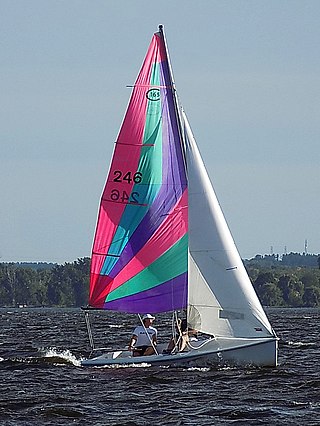
The Catalina 22 is an American trailerable sailboat that was designed by Frank V. Butler and first built in 1969.

The Com-Pac 16 is an American trailerable sailboat that was designed by Clark Mills as a small cruiser and first built in 1972.

The Catalina 16.5 is a series of American sailboats, that was designed by the Catalina Design Team and first built in 1994.
The Newport 41 is a family of American sailboats that was designed by C&C Design as International Offshore Rule (IOR) racer-cruisers and first built in about 1972.
The Aquarius 23 is an American trailerable sailboat that was designed by Peter Barrett and Stan Miller as a cruiser and first built in 1969.
The Balboa 22 is an American trailerable sailboat that was designed by W. Shad Turner and William M. Downing as a cruiser and first built in 1977.
The Columbia 22 is an American trailerable sailboat that was designed by William Crealock and first built in 1966.
The Dehler 25 is a German trailerable sailboat that was designed by E. G. van de Stadt as a cruiser and first built in 1984.
The Gloucester 19 is an American trailerable sailboat that was designed by Stuart Windley and Harry R. Sindle as a day sailer and first built in 1983.
The Gloucester 22 is an American trailerable sailboat that was designed by Stuart Windley and Harry R. Sindle as a cruiser and first built in 1983.
The Lockley-Newport LN-23, also called the Gloucester 23, is an American trailerable sailboat that was designed by Stuart Windley and Harry R. Sindle as a racer-cruiser and first built in 1978.
The Gloucester 20 is an American trailerable sailboat that was designed by Stuart Windley and Harry R. Sindle as a pocket cruiser and first built in 1981.
The Lockley-Newport LN-27 is an American sailboat that was designed by Stuart Windley and Harry R. Sindle as a cruiser and first built in 1979.
The Gloucester 27 is an American sailboat that was designed by Stuart Windley and Harry R. Sindle as a cruiser and first built in 1983.
The Irwin 25 is an American trailerable sailboat that was designed by Ted Irwin as a cruiser and first built in 1969.
The Montgomery 17 is an American trailerable sailboat that was designed by Lyle Hess as a pocket cruiser and daysailer and first built in 1973.
The Neptune 24 is an American trailerable sailboat that was designed as a cruiser and first built in 1978.
The RK 20 is an American trailerable sailboat that was designed by Lyle C. Hess as a cruiser and first built in 1972.
The Seafarer 24 is an American trailerable sailboat that was designed by McCurdy & Rhodes as a cruiser and first built in 1974.
The Windrose 22 and Laguna 22 are a series of American trailerable sailboats that were designed by W. Shad Turner as cruisers and first built in 1977.



